What Is That Stuff?
Don't be alarmed if you see white cottony patches on your santa rita cactus! ( Opuntia violacea var. santa rita ) We often find clumps of the wooly-cottony substance on our plants. We find it more often in humid warm weather, but, today noticed a healthy- looking cluster on one of our cactus, even in the cooler weather...yesterday low, 35 degrees, here.
The cactus is native of Texas, Arizona and Northern Mexico but grows very easily here, in Borrego. A mature plant is an outstanding addition to a desert garden. Our garden contains several specimens.
Before you worry too much about what causes the patches, let me assure you, they are very easy to control! Just hose them off with water from the strongest setting your nozzle has...and keep washing until they are gone. Sometimes , you will see a whitish puddle of water containing the "cotton". If you haven't removed all and notice others, wait a few weeks and repeat the process.
The Beetles!
The Cochineal beetle sticks her nose into the cactus pad to get nourishment. She secretes the white cottony substance to hide and to prevent drying out. She stays in one place but the male has wings and can fly to females for fertilization purposes...after which, he dies. The female is wingless, but her cotton patch will grow into colonies following fertilization and spread about the leaf and plant.
Lots of Uses...
This little beetle produces carminic acid, which can be extracted from her body and eggs to make carmine dye, now used as a food coloring (E120 on the food label) and in rouges, lipsticks, jams. preserves, sauces, meats, poultry and many other places, such as the stain for slides in microbiology.
Historic Beetles!
The Aztec and Maya people long used the dye for fabrics and valued its vivid red- purple color. When the Spanish entered the picture, they saw the value in the product and took it back to Europe and kept it as a State secret. Called the "royal" color, it was available to only the rich. They controlled the market and it wasn't until late 1700 that the rest of the world was let in on the secret!
See for Yourself!
I took a metal pick and scraped off a gob of cotton. With a lens, I looked into the sticky mess and noticed the body of the beetle. I squeezed it and saw the bright red drops of a blood-like substance. It got on my fingers, along with some glochids, and dyed my thumb purple - is it indelible? I'll let you know !
The time has come, the lizard said, to talk of many things...of carrots, beets and rainbow chard...of peas and beans and raptor wings...why the sand is burning hot and why Borrego sings!
WELCOME ...A new resident ? Love the desert? Gardening a passion? Live in Borrego Springs? Thought you could not have a garden in the low desert desert? Ever wonder what desert living is like? READ ON !
Raised Vegetable Beds
Raised Vegetable Beds Resting Until Fall Planting Season
Palo Verde
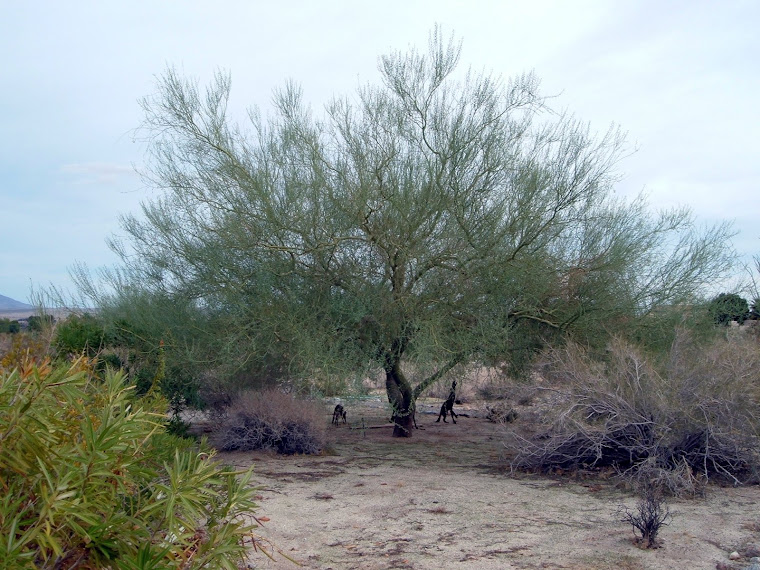
Desert Native, Blue Palo Verde
A River Runs Through It
View Through A Wet Window
Sunday, November 28, 2010
Wednesday, November 24, 2010
The Giant Radishes
The giant radishes have appeared! Each year, I plant more seeds than we need...this year, no exception - and I thought I was being so careful to plant no more than we could eat! My little row of radishes surrounding the lettuce has produced these huge things that we are trying to eat as fast as we can.
It's the same old pattern...a few years ago I gave some vegetables to a friend ( along with some big radishes ). A few days later she called to tell me how much she enjoyed the parsnips ! She had actually boiled them and told me they were delicious!
It's the same old pattern...a few years ago I gave some vegetables to a friend ( along with some big radishes ). A few days later she called to tell me how much she enjoyed the parsnips ! She had actually boiled them and told me they were delicious!
Thursday, November 18, 2010
Re-Cap, Desert Gardeners November Meeting
Jerry Rowling showed the group several water meters and told us how to understand our water bill. He advised turning all household water off and looking at the water meter to detect an outside leak. If inside water is off and the meter is still registering, you have a leak. First, check all hose connections:
There are 7.48 gallons of water in 1 cubic foot. On your water bill, one unit of water equals 100 cubic feet, or 748 gallons of water. The water district charges $1.12 per unit. Now, consider: A faucet leak of one drop per second equals 7.5 gallons per day - 225 gallons per month, 2,700 gallons per year A stream of water from a hose left running at about 5 gallons per minute, would be 7,200 gallons per day - $10.78 or (heaven forbid) if you forgot it for a month, it would cost you an extra $323.42! I have been guilty of letting the hose drip onto plants for a period of time. It is so EASY to forget...NO MORE! I just, somehow, had never thought of it in those terms.
Check the same way for inside leaks. First, turn off any outside water. Be sure no inside appliances or faucets are running. Look at the meter. If it is still turning, you have an inside leak. Check your toilets first to see if they are running. If you can't detect any leak, a drop of food coloring in the tank will provide evidence. If you have no inside leaks, your meter should be still.
Tom Fredericks noted that, due to our granular and sandy soil, which absorbs water at the rate of two inches per hour, finding an outside leak is a difficult task. He also stated that deep watering here ( Borrego Springs ) does not have the same effect as in other locales. My take...if you like to water by hand ( I do )a little sprinkle now and then doesn't hurt...but, don't let the hose run because it can't turn itself off!
In conclusion, Jerry stated that pipes have a life expectancy of 15-20 years, as do valves, timers and other parts of your irrigation system. The best protection is paying attention to your entire watering system, meter included!
There are 7.48 gallons of water in 1 cubic foot. On your water bill, one unit of water equals 100 cubic feet, or 748 gallons of water. The water district charges $1.12 per unit. Now, consider: A faucet leak of one drop per second equals 7.5 gallons per day - 225 gallons per month, 2,700 gallons per year A stream of water from a hose left running at about 5 gallons per minute, would be 7,200 gallons per day - $10.78 or (heaven forbid) if you forgot it for a month, it would cost you an extra $323.42! I have been guilty of letting the hose drip onto plants for a period of time. It is so EASY to forget...NO MORE! I just, somehow, had never thought of it in those terms.
Check the same way for inside leaks. First, turn off any outside water. Be sure no inside appliances or faucets are running. Look at the meter. If it is still turning, you have an inside leak. Check your toilets first to see if they are running. If you can't detect any leak, a drop of food coloring in the tank will provide evidence. If you have no inside leaks, your meter should be still.
Tom Fredericks noted that, due to our granular and sandy soil, which absorbs water at the rate of two inches per hour, finding an outside leak is a difficult task. He also stated that deep watering here ( Borrego Springs ) does not have the same effect as in other locales. My take...if you like to water by hand ( I do )a little sprinkle now and then doesn't hurt...but, don't let the hose run because it can't turn itself off!
In conclusion, Jerry stated that pipes have a life expectancy of 15-20 years, as do valves, timers and other parts of your irrigation system. The best protection is paying attention to your entire watering system, meter included!
Labels:
irrigation,
leaks,
water bill,
water district,
water meter
Monday, November 15, 2010
Try Lime Curd!
Yesterday, on a bench outside the Post Office, I noticed two large boxes. I knew what was in them without even looking! MEXICAN LIMES. The glut of the extra heavy harvest is upon us and people are giving away their bounty before Thanksgiving. This is a regular occurrence in Borrego, where all kinds of citrus appear as if by magic - free for the taking-here and there throughout the village.
We have too many limes, too, and are thinking up ways to make use of them. I have been making lime pies, freezing zest and juice, trying to preserve them in water ( which only works for about several weeks ) and, more recently, making lime curd. WE LOVE CURD! I have already given away jars of it and am going to make more today. It is pretty, has a refreshing sweet sour taste and is great on English muffins or bagels. We prefer it to jam. Recipe follows: ( Betty Crocker )
1 cup sugar, 1 cup lime juice, 1 tablespoon finely grated peel, 3 tablespoons butter, cut up, 3 eggs. In 1,1/2 quart saucepan, mix lime juice, sugar and grated peel with a whisk. Stir in slightly beaten eggs and butter. Cook over medium heat, stirring constantly until mixture coats the back of your spoon. Don't boil. Pour into a one pint container or two one cup containers. Will keep up to two months in the refrigerator.
A tip: I use the fine grate attachment on the food processor to grate peel. About four limes at a time can bounce around until peel gets thin. The limes may still be juiced, afterwards.
We have too many limes, too, and are thinking up ways to make use of them. I have been making lime pies, freezing zest and juice, trying to preserve them in water ( which only works for about several weeks ) and, more recently, making lime curd. WE LOVE CURD! I have already given away jars of it and am going to make more today. It is pretty, has a refreshing sweet sour taste and is great on English muffins or bagels. We prefer it to jam. Recipe follows: ( Betty Crocker )
1 cup sugar, 1 cup lime juice, 1 tablespoon finely grated peel, 3 tablespoons butter, cut up, 3 eggs. In 1,1/2 quart saucepan, mix lime juice, sugar and grated peel with a whisk. Stir in slightly beaten eggs and butter. Cook over medium heat, stirring constantly until mixture coats the back of your spoon. Don't boil. Pour into a one pint container or two one cup containers. Will keep up to two months in the refrigerator.
A tip: I use the fine grate attachment on the food processor to grate peel. About four limes at a time can bounce around until peel gets thin. The limes may still be juiced, afterwards.
Wednesday, November 10, 2010
A New Photo !
The mornings are SO glorious this time of year...I decided to share. Old photos may still be seen by scrolling down!
Update, Raised Beds
We had our first salad from the winter garden last night! I pulled (thinned) several lettuce plants and nipped others, Radishes are mature enough to eat, now. Notice open places in the beds, already seeded with more lettuce and carrots. Chard is already to start cutting. I cut off outside leaves and use them. Chard will continue to produce into summer months. Tomatoes all are showing flowers. I kept red and white onion sets in the refrigerator over the summer and set them in a row fronting tomatoes. All are growing. Beets seeded in front of them two weeks ago are showing growth. Planted marigolds along outer edge. All up and showing growth. Had trouble with the spinach seeds. A few germinated but were quickly removed by some critter. Started a new batch in seed flats. Most have germinated. The plan: Set them out in circle bed on outer edge of peas. By the way...more trouble with the disappearing peas - I planted the second bunch about a week and one half ago. Covered with extra heavy shade cloth, weighted with rocks. About 1/4 germinated and , again, suspicious holes where the rest had been planted. These rats and mice must have deep pockets and I'll bet they are dancing around gleefully during the late night feasting! They are in for a surprise, though. Cayenne pepper will be sprinkled around my third attempt! I also read that cotton balls soaked in oil of peppermint is a rodent deterrent. If cayenne fails, BEWARE! Plan B has already been devised! Peas are our favorite vegetable and we do intend to keep trying!
Our raised beds were first seeded on September 29th. And it is still not too late to plant ! Note that the drip irrigation is in and my hand watering has ended. Currently running for 10 minutes daily ( early morning ) and seems to keep the beds moist. I think the organic potting soil and compost has enhanced the growth greatly.
Our raised beds were first seeded on September 29th. And it is still not too late to plant ! Note that the drip irrigation is in and my hand watering has ended. Currently running for 10 minutes daily ( early morning ) and seems to keep the beds moist. I think the organic potting soil and compost has enhanced the growth greatly.
Monday, November 8, 2010
The Mexican Lime
In the early days of long voyages, many sailors died due to the dreaded disease, scurvy. Had they known of Citrus, things would have been different!
We did not plant our trees to prevent scurvy but because we enjoy the tropical aroma of blossoms in the springtime, the winter fruit and juice they provide and the shiny green leaves they display. Of all our citrus, our favorite is the Mexican lime. We had planted a Bearss, touted as the best lime for Southern California but, at least in our area, found the Mexican lime to be superior. We removed the Bearrs and kept the Mexican lime.
The lime tree, Citrus aurantifolia, has awful thorns...not to worry! When ripe, the fruit turns pale yellow and drops from the tree. The small fruit is easy to squeeze because it has a thin skin. Bartenders use it almost exclusively. If you have traveled in Mexico, you have noticed it is served with everything and used in food preparation, from ceveche to beef , fish, soups and fruits. It is the wedge served with cerveza and the fruit used to make Key lime pie ( another alias for Mexican lime ) It is sold in all the mercados and small tiendas throughout Mexico. I have experimented and make a delicious Mexican lime pie. (Use your favorite lemon pie recipe, substitute lime juice for lemon but increase zest to two tablespoons, add 1 drop of green vegetable food color. ) I freeze the juice and zest for later use. Best of all, even when you think the harvest is over you can find a leftover hanging on the tree. We have had fruit on the tree in winter and summer!
Limes have been used for centuries as a prevention or cure for many maladies. They have been used as a digestive aid, to treat gout, to lose weight, to treat insect bites, as antibiotics and disinfectants, for vitamin C deficiency and many other remedies. The oil is used in cosmetics. The peel is fed to cattle.
The tree is sensitive to freezing and probably does best in the higher parts of Borrego basin. It is about the only Citrus that can be grown from seed and remain true to the parent plant. It can tolerate drought but responds favorably to a regular watering regimen.
We love our lime tree !
We did not plant our trees to prevent scurvy but because we enjoy the tropical aroma of blossoms in the springtime, the winter fruit and juice they provide and the shiny green leaves they display. Of all our citrus, our favorite is the Mexican lime. We had planted a Bearss, touted as the best lime for Southern California but, at least in our area, found the Mexican lime to be superior. We removed the Bearrs and kept the Mexican lime.
The lime tree, Citrus aurantifolia, has awful thorns...not to worry! When ripe, the fruit turns pale yellow and drops from the tree. The small fruit is easy to squeeze because it has a thin skin. Bartenders use it almost exclusively. If you have traveled in Mexico, you have noticed it is served with everything and used in food preparation, from ceveche to beef , fish, soups and fruits. It is the wedge served with cerveza and the fruit used to make Key lime pie ( another alias for Mexican lime ) It is sold in all the mercados and small tiendas throughout Mexico. I have experimented and make a delicious Mexican lime pie. (Use your favorite lemon pie recipe, substitute lime juice for lemon but increase zest to two tablespoons, add 1 drop of green vegetable food color. ) I freeze the juice and zest for later use. Best of all, even when you think the harvest is over you can find a leftover hanging on the tree. We have had fruit on the tree in winter and summer!
Limes have been used for centuries as a prevention or cure for many maladies. They have been used as a digestive aid, to treat gout, to lose weight, to treat insect bites, as antibiotics and disinfectants, for vitamin C deficiency and many other remedies. The oil is used in cosmetics. The peel is fed to cattle.
The tree is sensitive to freezing and probably does best in the higher parts of Borrego basin. It is about the only Citrus that can be grown from seed and remain true to the parent plant. It can tolerate drought but responds favorably to a regular watering regimen.
We love our lime tree !
Thursday, November 4, 2010
DESERT GARDERNERS MEETING Friday, , November 12, 10 AM - 11:30 AM
Jerry Rolwing, from the Water District will show you how to read your water meter and how to find water leaks. Learn how to monitor your water usage and never again be surprised by your water bill! Call water department for location of the meeting. ( at a private residence )
As always, the meeting will be outside. Bring your own chair and water. Hope to see you there!
Jerry Rolwing, from the Water District will show you how to read your water meter and how to find water leaks. Learn how to monitor your water usage and never again be surprised by your water bill! Call water department for location of the meeting. ( at a private residence )
As always, the meeting will be outside. Bring your own chair and water. Hope to see you there!
Wednesday, November 3, 2010
Citrus
Everyone visiting Borrego has noticed the acres and acres of Citrus trees...we are known for our famous "Borrego Reds" ( grapefruit ). We took immediate notice and started planting citrus trees on our lot long before the house construction was completed. Take it from us - if you like to eat citrus fruit, you need plant only a few trees. They will supply all your needs. Though citrus thrives in our area, the trees do require adequate water and fertilization to offer bumper crops of fruit.
Of our original "mini grove" , ten trees are left, producing more than we want or need...in fact, though we love to give away fruit, it is often hard to find recipients! Little by little, our citrus trees are being replaced by native, less thirsty trees. We are narrowing them down according to our favorites. We love the Marsh seedless along with a red grapefruit variety. We like the Mission orange tree, which always produces lots of sweet tasting, tangelo-like fruit. We like the Meyer lemon ( dwarf ) and absolutely cannot do without the Mexican lime. We very easily could do without the rest of the trees. Those five trees could supply all our needs and then some!
If you do plant Citrus in your garden, shop around and taste the fruit before you plant. There is much information in books, magazines or on the net regarding the care of citrus. It is worthwhile to do your homework before you buy!
Of our original "mini grove" , ten trees are left, producing more than we want or need...in fact, though we love to give away fruit, it is often hard to find recipients! Little by little, our citrus trees are being replaced by native, less thirsty trees. We are narrowing them down according to our favorites. We love the Marsh seedless along with a red grapefruit variety. We like the Mission orange tree, which always produces lots of sweet tasting, tangelo-like fruit. We like the Meyer lemon ( dwarf ) and absolutely cannot do without the Mexican lime. We very easily could do without the rest of the trees. Those five trees could supply all our needs and then some!
If you do plant Citrus in your garden, shop around and taste the fruit before you plant. There is much information in books, magazines or on the net regarding the care of citrus. It is worthwhile to do your homework before you buy!
Monday, November 1, 2010
What Time Is It?
For many years, the end of Pacific Daylight Time has coincided with the Borrego Days Parade. Our house guests have always appreciated the extra hour of free time received prior to their departure.
This year, I went about resetting all the clocks Saturday night - even those on the handsets, to Pacific Standard Time. Fast forward to the evening T. V. programs Sunday evening. Nothing was on schedule! Had they forgotten about the time change? And, the morning paper was delivered extra early! The morning news program must have been changed, too! We looked at our cell phones- they were also off an hour...but, we KNEW they are always accurate. Could we have been wrong? I asked Wikipedia..."when does standard time begin?" , found out and decided to let the clocks stay as they were...we'd remember the difference...then, we had a one minute power outage...reset everything to Daylight Time. FYI...It's NEXT week!
The topper: My friend called early this morning and said, " You'll never guess what I did! " I replied, " I'll bet I can ! " And, we compared our funny experiences.
This year, I went about resetting all the clocks Saturday night - even those on the handsets, to Pacific Standard Time. Fast forward to the evening T. V. programs Sunday evening. Nothing was on schedule! Had they forgotten about the time change? And, the morning paper was delivered extra early! The morning news program must have been changed, too! We looked at our cell phones- they were also off an hour...but, we KNEW they are always accurate. Could we have been wrong? I asked Wikipedia..."when does standard time begin?" , found out and decided to let the clocks stay as they were...we'd remember the difference...then, we had a one minute power outage...reset everything to Daylight Time. FYI...It's NEXT week!
The topper: My friend called early this morning and said, " You'll never guess what I did! " I replied, " I'll bet I can ! " And, we compared our funny experiences.
Subscribe to:
Posts (Atom)
A New Borrego Garden Path
New Path Under Construction, Indian Head Ranch
Pathway
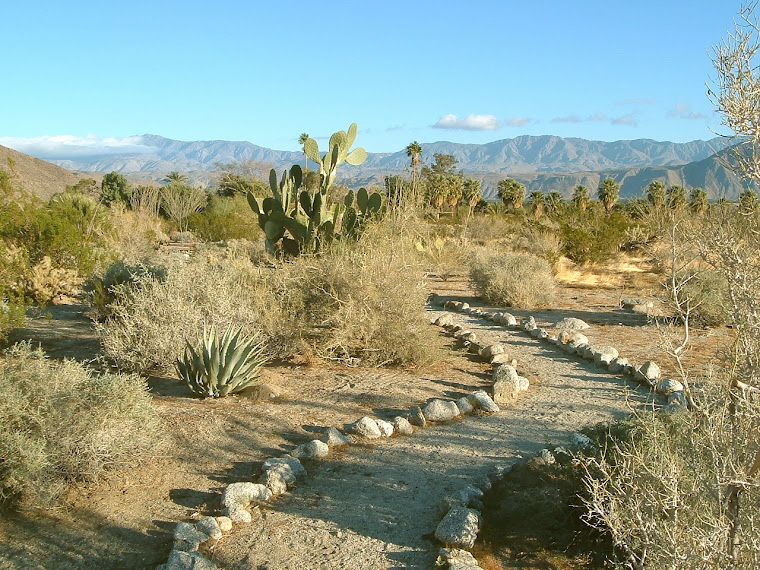
Easy to Maintain Garden Path
It's a Boojum...

Not an Ocotillo
Boojum

Captivating Top Knot
Colorful Vine
In a Hidden Niche
Bees and Flowers
Mexican Lime- Bees at Work
Citrus Blossoms
Exotic Aroma
Ocotillo
On a Cloudy Day
Four Raised Beds, October
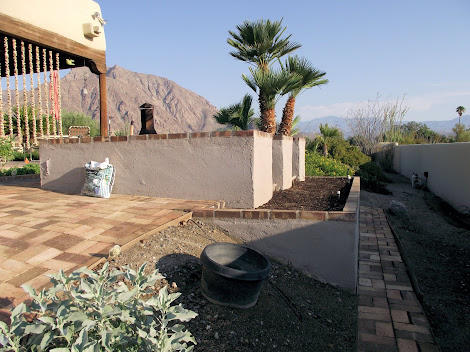
Vegetable Garden
Desert Gardening
Desert gardening...what a pastime. Natives anxious to attack with thorns, stickers or burrs - earth always thirsty - critters always a step ahead of you - dainty moths turn into hungry caterpillars - coyote eats up part of the irrigation system - birds sample one fruit at a time - gopher pops up unexpected . Yet the first carrot, pea or tender piece of lettuce, the first lime or lemon of the season, the first cactus bloom , the first bright green mesquite sprig, the first bud on a plant...all give such a feeling of delight and satisfaction. Not to be traded for anything else! (JGP)
Super Addiction
When I started the blog, I thought a few words now and then would suffice...WRONG!
A strange pattern is emerging. Seems that guilt has stepped up to bat. Now, if I don't post every few days I FEEL THAT I HAVEN'T HAD MY FIX! I wonder if other bloggers have noticed this same phenomenom.
A strange pattern is emerging. Seems that guilt has stepped up to bat. Now, if I don't post every few days I FEEL THAT I HAVEN'T HAD MY FIX! I wonder if other bloggers have noticed this same phenomenom.
Beavertail
Close-up
Borrego Dragon
Huge New Sculpture
The Borrego Dragon Fable
IN THE EARLY DAYS, coyote walked many paths. One day, as he was pursuing his travels, he came to a very wide valley. Others warned him as he approached the valley, " You must not enter this place...NO ONE who has entered has ever returned. It is a bad place, guarded by a giant dragon, who kills all who try to pass through. To continue your journey safely, we strongly advise you to go the long way...around this evil place." Well, coyote listened, for he was very smart and often heeded good advice. However, coyote was also lazy and was often prone to use shortcuts. He figured the valley would save him a lot of time on this particular journey. He looked carefully and saw nothing much to alarm him. He decided to enter and pass through the valley. At first, he noticed nothing amiss. However, as he traveled deeper into that still, quiet place, he thought to himself, "This IS an unusual valley, for sure...I see no movement of any type and I am getting to feel a bit strange about this place." He did notice, however, some tall straight trees which had lost all their leaves and made the place look barren, indeed. OH,NO...he also noticed, under the trees, piles of old BONES... and the more he looked, the more bones he saw. He said, " I sure see a lot of bones, but I don't see any dragon...I'll bet he no longer lives here." And, with that, he heard a thunderous voice which echoed over the valley..." HAH, COYOTE! You should have listened to the advice...You are in my mouth, which IS the entrance to the valley!" Oh,oh, caught in a trap. But coyote is smart and moves quickly...as he heard Dragon's first words, he raced to one of the dead trees and, with a mighty yank, pulled it from the earth. He wedged the tree between the Dragon's jaws and as he did this, many animals of all kinds came running forth...pumas, bears, mountain sheep and more...even the smallest animals, gnats, flies, tics, bees and more...lizards, snakes, toads, salamanders and more...all ran from the Dragon's depths to freedom. Coyote watched as Dragon's jaws closed upon the sharp tree stake. He soon died and from that time to this, many of those same animals live here, in this place...and from time to time, many of the old bones and pieces of the dead trees are found here, in this very valley!
Senita Cactus
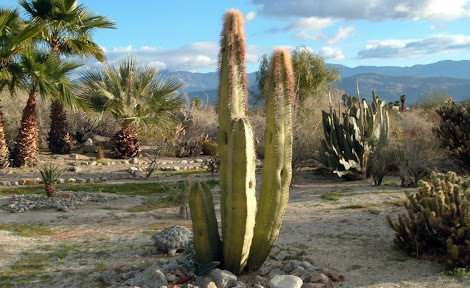
Plump and Happy
Outlaws
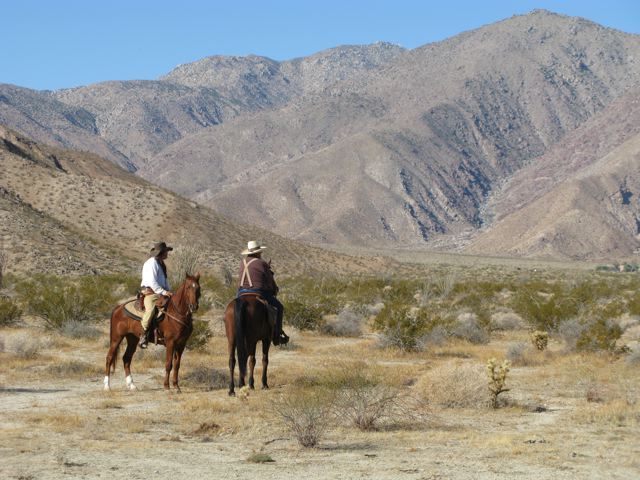
Riders View Borrego's Wilderness (photo by Jeff Divine )